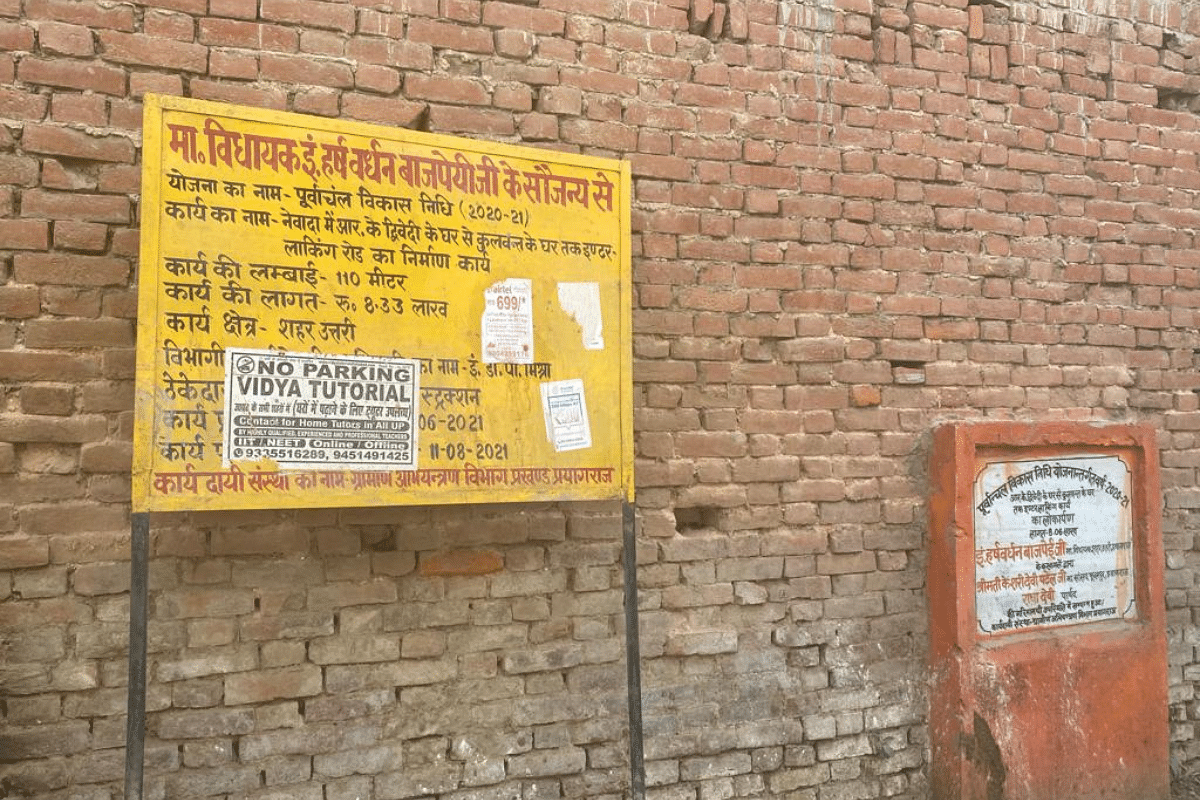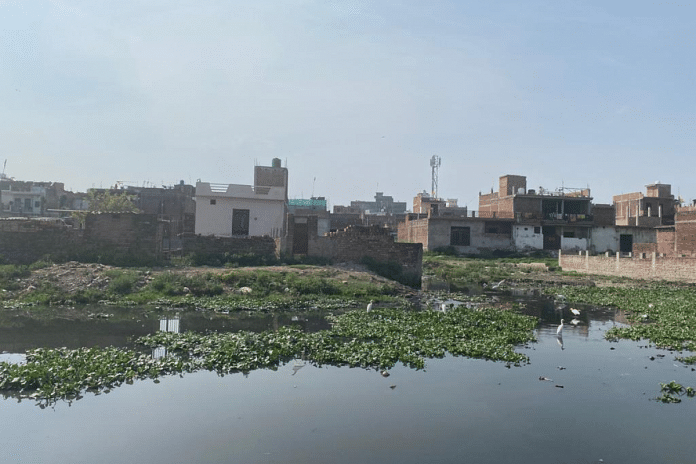Prayagraj: Sewage water surrounds the two-storey house of Deepak Kesarwani, a kirana store owner in Prayagraj, from all sides. Worse, his ground floor gets flooded every year forcing his family of three to move to the first floor for about a month during monsoon.
Reaching his home at the Newada area in the Ganga floodplains is a task itself as visitors have to watch every step while walking on a narrow broken path.
“There are at least 50,000 houses here and lakhs across the floodplains. I am not alone. Nothing will happen. If a bulldozer rolls, it will apply to everybody and the government won’t demolish our houses just like that,” Deepak says to a query about demolition drives that are being carried out to raze illegal houses in areas like Dhoomanganj, Kareli, and Jhunsi.
In Prayagraj, action on properties of jailed gangster-turned-politician Atiq Ahmed and his associates has revived a debate on how illegal colonies mushroomed across the city, especially the floodplains, despite a 2011 order of the Allahabad High Court banning construction within 500 m from the highest flood level of the Ganga.
As the Uttar Pradesh government is cracking down on Atiq Ahmed, the Prayagraj Development Authority (PDA) has informed the Department of Housing and Urban Planning that it has identified 30,715 illegal constructions – the highest in the state.
Prayagraj is followed by Varanasi (24,758) and Gorakhpur (23,389), according to the data submitted to the housing department. The numbers were up to the period of 28 February.
The data collated from all development authorities was uploaded on the housing department’s portal, official sources said, adding that the government directed them to prepare a roadmap to “dispose of” illegal constructions.
A PDA official told ThePrint that the maximum number of illegal properties were identified in areas like Naini, Jhalwa, Jhunsi, Sulemsarai and Phaphamau and in the outer areas of Prayagraj.
Asked about such illegal colonies in floodplains of Prayagraj, principal secretary (housing) Nitin Ramesh Gokarn says the department has sought an action plan from different authorities for action against such illegal constructions. In floodplains, demolition is the only solution, he agrees.
Are the numbers fudged?
Senior advocate Arun Gupta, the amicus curiae in the Ganga pollution case which led to the 2011 construction ban ruling, says that the numbers are very less as ‘kacchhar kshetra’ (floodplains in local parlance) has illegal colonies spread across Prayagraj.
“Some colonies were built before the court order, but thousands of houses have come up even after the ban. Lakhs of houses have come up in Kareli, Daraganj, Neeva, etc. During the case proceedings, the government filed several affidavits and shared the details of constructions on directions of the court,” he says.
The case of Sunil Kumar, a plumber whose father arrived from Jaunpur 20 years ago, exemplifies how the colonies mushroomed in the floodplains.
Like Deepak, Sunil too knows that his house is in ‘kacchhar kshetra’. “When we built the house, there were hardly any homes here. My father was a clerk in the pension department and land was much cheaper here than in the city. We have electricity and water connections. The sewer line is very old. There are houses of judges, lawyers and government officers. A local councillor, Pawan Bharti, has sold several plots here,” he tells ThePrint.
ThePrint visited a grey colour three-storey house of Bharti in the floodplains.
“The court order prohibits construction within 500 m from the highest flood level. If one goes by that criteria, a huge part of Prayagraj is full of floodplains, with the water level high at some places and low at others. There is a big drain flowing from Rajapur to Newada which causes floods. People who buy properties here can’t afford a house in the heart of the city where 100 sq m of land costs about Rs 1.5 crore. Working class families, including rickshaw wallahs and drivers, buy land here. Government should provide them housing if it doesn’t want constructions…,” Bharti contends.
While he admits to selling off several plots, the councillor claims those were either his ancestral land or of his kin.
Land mafia & political nexus
“There is no doubt that the mafia has acquired land forcefully here. Many work as lawyers,” Bharti says.
As ThePrint surveyed Newada and Ashok Nagar areas, houses with nameplates of retired judges, as well as of lawyers and IPS officers revealed why constructions go unchecked in the Ganga and Yamuna floodplains.

Gupta alleges that there is a nexus of politicians, builders and government officers behind the unrestrained construction.
He also blames the Prayagraj Development Authority for failing to check such constructions. “There are government offices, too, in floodplain areas. There is a hotel of the tourism department, an STP-plus pumping station. It is the responsibility of the PDA and the local bodies to ensure that such constructions are checked, but still lakhs of houses have come up,” the advocate says.
After the disastrous 1978 floods, pillars were installed to identify the Highest Flood Level (HFL) area near places like Baba Chauraha to stop further constructions. “Pillars were installed at several places on several occasions to stop constructions within HFL limits. But due to the nexus of the mafia, local police and administration, the pillars have been uprooted more than once,” Gupta claims.
Retired judge Nishesh Bajpai, who has a house at Patrakar Colony in Ashok Nagar area, asserts while his colony was set up sometime in 1988-89, more and more people have built houses in the floodplains and are constructing further.
“Some of the maps of the houses have been approved by the PDA. Once, the area was even marked to ensure no further construction. But more buildings have come up and many more are being built in the floodplains as we go further towards the Ganga,” he says.
Roads built with govt funds
Sunil’s wife Meera Devi says Allahabad North MLA Harshvardhan Bajpai helped to build an interlocking road connecting the houses at a colony in Newada about two years ago. Other families like Deepak’s are also demanding similar roads now.

While a yellow board installed at a corner of the road leading to Sunil’s house has details of the interlocking road built under the ‘Poorvanchal Vikas Nidhi-2020-21’, a plaque mentions its inauguration by the MLA in the presence of Phulpur MP Keshari Devi.
Asked about such roads being built with government aid, Bajpai says mismanagement has happened in the past and it is difficult to deprive lakhs of people of basic amenities.
He admits to the involvement of land mafia, local police and PDA officials behind the proliferation of such colonies. “Construction should not have been allowed in the first place. It has become another Dharavi, but no one has been able to solve the problem. Many pillars were put up to demarcate the floodplain area to avoid further construction, but mischievous elements removed them. There is involvement of land mafia, local police and PDA, else how have so many illegal colonies sprouted over the years,” he says.
The local MLA asserts he had highlighted the issue in the Vidhan Sabha and has suggested that a ribbon road be built to demarcate the HFL area for stopping constructions.
Explaining the larger conundrum, a PDA official says the Authority is supposed to stop such illegal houses but the Nagar Nigam gives facilities to these colonies. “The registry department continues to register such properties. They carry out registrations despite our objections as it helps them earn profit,” the official claims.
Ajay Kumar, joint secretary, PDA says the Authority puts pressure on owners of illegal properties to get their building maps sanctioned.
“Many illegal properties were identified and their owners pressured to get the maps sanctioned to legalise them after payment of compounding fees. However, constructions in floodplains cannot be legalised and have to be demolished at the end, but practically demolition is not possible,” he says.
ThePrint contacted PDA vice-chairman Arvind Chauhan for a comment via phone and a text message, but his response is awaited.
Back at Newada, Deepak’s confidence shows why there’s no stopping of constructions. “A judge has also built a house here. There are IPS officers and politicians, too. If a bulldozer rolls, the government will have to find an alternative,” the kirana owner says.
Others like Yaad Mohammed in Newada are less circumspect. “These houses have come up over the last 35 years. Now, people are selling land within just a few meters from the Ganga bank. They know nothing will happen to them.” The shopkeeper says he is prepared for another spell of rains in August when his family will shift to the first floor.
(Edited by Tony Rai)
Also Read: ‘Symbol of slavery & indulgence’: Idea behind BJP’s renewed demand to rename Lucknow



